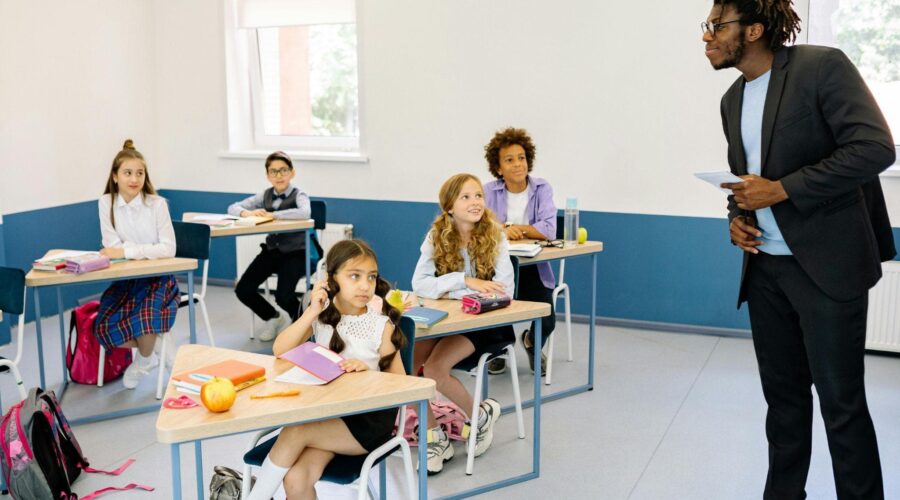When we talk about the future of Texas, what are we talking about? We’re talking about our children, their boundless potential, and the quality education that will empower them to build a vibrant, prosperous tomorrow. Public education in Texas: Investing in Our Kids’ Future isn’t merely a catchy phrase; it’s a critical, urgent call to action that resonates across every community. Our public schools are the indispensable bedrock of opportunity, the launching pad for countless dreams, and right now, they demand our unwavering attention and significant, strategic investment. We bear an immense responsibility to ensure that every single child in our great state, regardless of their zip code or background, receives nothing less than a top-tier education. This commitment isn’t just about charity; it’s about shrewd foresight for the entire state.
The Current Landscape of Texas Public Education
Texas, a state renowned for its immense growth, vast geographical expanse, and incredible diversity, boasts a public education system that’s as expansive as its cultural tapestry. From the bustling, dynamic urban districts to the sprawling, tight-knit rural communities, our schools tirelessly serve millions upon millions of students each day, each individual possessing unique needs, innate talents, and burning aspirations. This sheer scale, while impressive, presents both remarkable strengths and formidable challenges. We rightly celebrate the profound dedication of countless educators who pour their hearts into their work and the bright, innovative minds consistently emerging from our classrooms, ready to tackle the world. However, we must also confront the stark, undeniable realities of an often-strained system. Our current funding mechanisms, heavily reliant on local property taxes, inadvertently create glaring, deeply rooted disparities. Some districts, blessed with robust tax bases, truly flourish, while others, perpetually underfunded, struggle to provide even the most fundamental resources. This isn’t just an abstract financial problem; it impacts real children, real families, and their very real futures, shaping the trajectory of their lives.
Challenges and Opportunities
Let’s be candid about the hurdles confronting Texas public schools. Large class sizes are a common complaint, often translating into less individualized attention for students – a critically important factor in their unique learning journeys. How can a teacher effectively reach every student when managing a classroom the size of a small village? Outdated infrastructure, ranging from perpetually leaky roofs to a glaring lack of modern technology, can severely hinder effective teaching and active learning. Moreover, perhaps the most pressing issue is the profound disparity in resources across districts. While some schools boast cutting-edge science labs, state-of-the-art sports facilities, and robust extracurricular offerings, others are struggling to obtain adequate textbooks, basic classroom supplies, and even functional heating and cooling systems. Yet, within these very challenges lie immense opportunities for transformative change. We have the opportunity to innovate, share best practices meticulously across districts, and strategically allocate resources to bridge these glaring gaps. Imagine every single school in Texas, regardless of its urban or rural setting, its socioeconomic status, offering the same foundational, high-quality learning environment. Is that not a future truly worth striving for, one that benefits every Texan?
Actionable Steps for Improvement
So, how do we transcend mere acknowledgment of these pervasive problems and transition into the concrete implementation of solutions? It demands a deliberate, multi-pronged approach – a genuine, unwavering commitment to systemic change. We cannot simply wish for better schools; we must actively, consciously build them. The path forward involves specific, actionable steps that, when implemented with conviction, can truly enhance and ultimately transform our public education system from the ground up, impacting every student who walks through those doors and every dedicated teacher standing at the front of the classroom. This is where the rubber meets the road.
Investing in Teacher Pay and Professional Development
Our teachers are, without exaggeration, the unsung heroes of our communities. They dedicate their lives, their energy, and their passion to nurturing young minds, often going above and beyond the call of duty with woefully limited resources. Yet, when compared to other professions requiring similar levels of advanced education, specialized skills, and profound dedication, their salaries too frequently fall tragically short. This simply isn’t sustainable for attracting the next generation of educators or retaining the experienced veterans we rely on. We urgently need competitive teacher salaries – not just adequate, but truly competitive – to attract the brightest and most passionate individuals to the profession and, crucially, to keep them firmly rooted in our classrooms. But it’s not exclusively about paychecks. We must also prioritize robust, ongoing professional development programs. Providing teachers with cutting-edge tools, relevant training, and unwavering support ensures they remain innovative, incredibly effective, and passionately dedicated to their vital, society-shaping work.
Enhancing Educational Resources and Infrastructure
Think about it for a moment: how can our children truly compete in an increasingly complex and demanding global economy if their classrooms feel stuck in the last century? Enhancing educational resources and infrastructure is not merely an option; it is an absolute necessity, a non-negotiable component of progress. This means thoroughly updating textbooks to reflect current knowledge and modern pedagogical approaches, providing ubiquitous access to cutting-edge technology like high-speed internet and modern computing devices for every student, and ensuring that all students have access to truly modern, inspiring learning environments. We’re talking about far more than just constructing new buildings; we’re talking about designing spaces that organically inspire creativity, foster crucial collaboration, and cultivate advanced critical thinking skills. Investing wisely in school infrastructure means safer, more energy-efficient, and inherently more conducive learning spaces for every single student and educator.

Implementing Innovative Curricula and Programs
The world is transforming at a breathtaking, unprecedented pace, and our educational curricula must not only keep up but lead the way. We need to move decisively beyond antiquated rote memorization and wholeheartedly embrace forward-thinking curricula that proactively equip students with the essential skills they’ll undoubtedly need for the 21st century: adaptability, complex problem-solving, creative thinking, and effective communication. This also fundamentally includes the strategic introduction of diverse, specialized programs that intelligently cater to a wide array of student interests, unique talents, and varied learning styles. Whether it’s robust STEM initiatives that inspire future scientists and engineers, comprehensive arts programs that foster creativity and cultural understanding, or practical vocational training pathways that prepare students for skilled trades, when we thoughtfully tailor education to meet individual needs, we unlock incredible, untapped potential within every child.
Funding Mechanisms and Policy Recommendations
At the very heart of any meaningful, sustainable improvement in public education lies adequate, equitable, and stable funding. We must critically examine our existing funding models and courageously propose innovative, progressive policy changes to ensure sustainable and truly equitable financial support for every public education institution across Texas. This isn’t just about spending more money; it’s profoundly about spending smarter, more transparently, and, most importantly, more fairly.
Exploring Alternative Funding Sources
Our current, heavy reliance on local property taxes as the primary funding mechanism creates an inherently uneven playing field, directly disadvantaging districts with lower property values. It’s high time to get creative and boldly explore alternative funding sources. This could involve dedicated state revenue streams derived from new or adjusted taxes, strategic partnerships with private industry and philanthropic organizations, or even exploring the potential of lottery proceeds specifically earmarked for educational initiatives. Diversifying our funding base will undeniably create a more stable, robust, and ultimately more equitable financial foundation for all Texas schools, ensuring that the property values never predetermine a child’s access to quality educational opportunities within their immediate neighborhood.
Legislative and Community Engagement
Real, lasting change rarely, if ever, happens in a vacuum. It demands a powerful symphony of concerted efforts from a multitude of committed players. Legislative action is absolutely paramount; our state lawmakers wield immense power to enact transformative policies that champion equitable funding, ensure fair teacher compensation, and implement much-needed curriculum reform. But equally vital is robust community involvement and advocacy. When parents, local businesses, and diverse community organizations unite, raise their collective voices, and lend their unwavering support, it creates an unstoppable force for good, capable of driving profound change. We can make a tangible difference by:
- Engaging parents, local businesses, and community organizations in school initiatives, fostering a true partnership.
Success Stories and Case Studies
Sometimes, seeing truly is believing. Across the vast expanse of Texas, and indeed, far beyond our state borders, there are shining, inspiring examples of educational excellence. These are not just isolated, fortunate incidents; they are invaluable blueprints for what is demonstrably possible when genuine commitment converges with innovative strategy and persistent effort. These success stories offer a beacon of hope and practical guidance.
Lessons Learned from Effective Programs
By meticulously studying these effective programs, we can glean invaluable insights and distill critical wisdom. What precisely made them so successful? Was it a particular, groundbreaking pedagogical approach, a uniquely effective funding model that circumvented traditional barriers, or an extraordinary level of collaborative community engagement that rallied everyone behind a shared vision? We must diligently analyze these pivotal factors and identify precisely how their successful strategies can be intelligently adapted and faithfully replicated across other Texas schools. It’s fundamentally about learning from the very best practices, dissecting their efficacy, and then strategically scaling those hard-won successes to benefit a wider network of students.

The Long-Term Benefits of Investment
Investing profoundly in public education isn’t merely about addressing the challenges of the present; it’s about strategically planting seeds for a flourishing, resilient future for generations to come. The returns on this critical investment are truly immeasurable, permeating and enriching every single facet of our society. It’s a generational gift, paid forward.
Economic and Societal Impact
A well-educated populace is, without a doubt, the indispensable backbone of a truly thriving state. It directly translates to a stronger, more competitive workforce, meticulously equipped with the advanced skills demanded by today’s rapidly evolving industries and tomorrow’s unforeseen innovations. It organically fosters increased innovation, as bright, diverse minds come together to collaboratively solve complex problems, spark new ideas, and create entirely new economic opportunities. Furthermore, it cultivates a more engaged, informed citizenry – active individuals, thoughtful participants in their communities and within our democratic processes. Ultimately, investing wisely and generously in our children’s education contributes directly to greater prosperity, enhanced social mobility, and a more equitable, vibrant society for all Texans.
CONCLUSION
The future of Texas, in its truest sense, literally rests on the developing shoulders of our children, and their ultimate success hinges, unequivocally, on the strength and vitality of our public education system. We’ve navigated the complexities of the current landscape, openly acknowledged the significant, systemic challenges, and meticulously outlined clear, actionable steps that possess the genuine power to make a profound, tangible difference. From ensuring competitive teacher pay and providing enhanced, modern resources to implementing truly innovative curricula and securing robust, equitable funding, the path forward is undeniably clear. It demands our collective will, our shared resources, and our unwavering commitment. Let’s remember this vital truth: Public Education in Texas: Investing in Our Kids’ Future isn’t merely an option; it is our shared imperative, our most sacred duty. Let’s work together, starting now, to tirelessly build the exceptional schools our children so desperately need and truly deserve.
